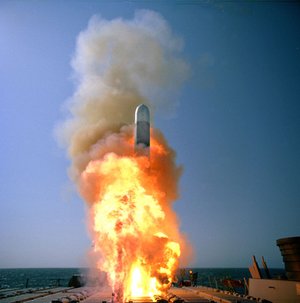BGM-109 Tomahawk
|
|
The Tomahawk Land Attack Missile (TLAM) is a long-range, all-weather, subsonic cruise missile with stubby wings. Introduced by General Dynamics in the 1970s, it was designed as a medium- to long-range, low-altitude aircraft that could be launched from a submerged submarine. It has been improved several times and is now made by Raytheon.
| Contents |
Description
There have been several variants, employing several kinds of warheads. The operational versions include the unitary conventional land attack TLAM-C, the bomblet-dispensing land attack TLAM-D, and nuclear land attack (TLAM-N) (not deployed). There is also the Tomahawk Anti-Ship Missile (TASM). Ground Launch Cruise Missiles and their truck-like launch vehicles were destroyed to comply with the 1987 Intermediate-Range Nuclear Forces Treaty.
The Block III TLAMs that entered service in 1993 can fly farther and use Global Positioning System (GPS) receivers to strike more precisely. Block IV TLAMs have a better DSMAC system, can loiter over a battlefield until called down, and pack better turbo engines.
Tactical Tomahawk: in-flight retargeting to one of 16 targets with GPS coordinates stored in its memory or to any other GPS coordinates. Offers commanders real-time pictures of the battlefield using its on-board camera.
Tomahawks are difficult to intercept, due to their small size and radar cross-section and low-altitude flight.

Each missile is stored and launched from a pressurized canister that protects it during transportation and storage and acts as a launch tube. These canisters are racked in Armored Box Launchers, as on the battleship Missouri, Vertical Launch Systems in other surface ships and the later Los Angeles-class submarines, and in submarines' torpedo tubes.
The missile is launched and steered for the first few seconds of flight by a solid fuel booster with steering vanes in its exhaust. Then the stubby wings and control surfaces are deployed, and the turbofan engine takes over. Over water, the Tomahawk uses inertial guidance to follow a preset course; once over land, the inertial system is aided by Terrain Contour Matching (TERCOM). Terminal guidance is provided by the Digital Scene Matching Area Correlation (DSMAC) system, producing a claimed accuracy of about 10 meters.
The Tomahawk Weapon System consists of the missile, Theater Mission Planning Center (TMPC)/Afloat Planning System, and either the Tomahawk Weapon Control System (on surface ships) or Combat Control System (for submarines).
Several version of control systems have been used, including:
TWCS - Tomahawk Weapon Control System (1983), also known as "green screens," was based on an old tank computing system.
ATWCS - Advanced Tomahawk Weapon Control System (1994), first Commercial Off the Shelf, uses HPUX.
TTWCS - Tactical Tomahawk Weapon Control System, (2003).
Other Details
- Total program cost: $11,210,000,000
Operators
United States Navy
In the 1991 Persian Gulf conflict, 288 Tomahawks were launched, including 12 by two attack submarines on April 2, 1991, the USS Pittsburgh (SSN-720) and USS Louisville (SSN-724).
Royal Navy
In 1995, the U.S. agreed to sell Britain more than 60 Tomahawks to arm Royal Navy (RN) nuclear submarines. The first missiles were acquired in 1998, with the first RN Tomahawk test also occurring that year. It is, as of 2004, in use with the Swiftsure and Trafalgar class nuclear fleet submarines, and it is planned all RN submarines will be Tomahawk capable by 2008. The Tomahawk will also be deployed by the future Astute-class nuclear fleet submarine. In 2004, the UK and USA governments reached an agreement for the UK to buy sixty-four of the new generation of Tomahawk missile, the Block IV or TacTom missile. The SYLVER vertical launch system to be fitted to the Type 45 destroyer is claimed to have the capability to fire the Tomahawk by its manufacturers. Therefore it would appear that Tomahawk is a candidate to be fitted to the T45 if the decision is made to fit her with cruise missiles. However, there is some doubt over the truth of the manufacturer's claims. France, which also uses the SYLVER launcher, is developing a version of the Storm Shadow/Scalp cruise missile capable of launch from the SYLVER system, which would give a similar land attack capability.
It was first used by the RN, when HMS Splendid fired Tomahawks during the Kosovo War in 1999. It was later used by the RN in the Afghanistan War in 2001, as-well as Operation Telic, the British contribution to the 2003 Iraq War.
